Through the camera lens
By Becky Barclay
Published in News on April 22, 2017 11:02 PM
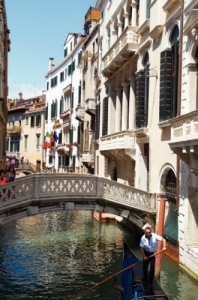
A man rows a gondola through Venice, Italy, in this photo that Dr. Samer Kasbari took.
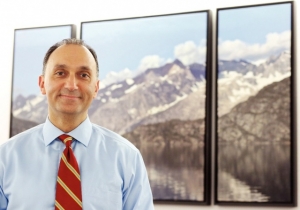
News-Argus/CASEY MOZINGO
Dr. Samer Kasbari stands in front of a photo he took at Glacier National Park in Alaska. Several photos he has taken at various places around the world hang on the walls of Southeastern Medical Oncology Center.
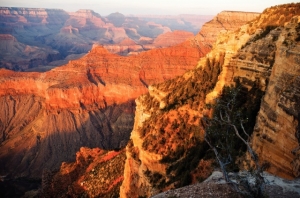
This photo was taken at the southern rim of the Grand Canyon.
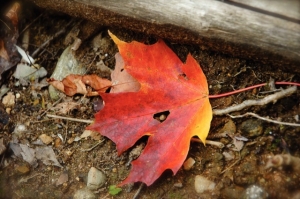
A single leaf lies by a tree during the fall season in Vermont.
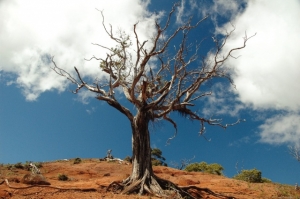
To get a photo of this tree, Dr. Samer Kasbari had to get off the trail he was on. He said most people think it's in a desert, but it's actually in an area of Waimea Canyon State Park in Kauai in the Hawaiian Islands.
Samer Kasbari can be at the edge of the Grand Canyon, in the mountains overlooking a lake or in a forest surrounded by foliage and he might stand there for a long time waiting to take the perfect photograph.
"So sometimes if you're waiting on me, I'll tell you don't wait on me," he said. "For me, I can spend an hour taking a picture. And some folks cannot even wait for two minutes. It's something that I strongly enjoy and I'm happy doing it. So time is no an issue when I'm taking pictures. I can spend hours on a trail taking pictures."
It's time well spent for Kasbari to come home with a breathtaking photo.
Kasbari began taking photos in high school. Then, in college, he got involved in the media center and was taking photos for the college, the yearbook and for various activities.
Although Kasbari took some photography classes in college, he is 90 percent self-taught.
During medical school, Kasbari delved into landscape photography.
"I enjoy taking pictures of the outdoors and places I visit and travel to," he said. "Every picture is a reminder of that place and thing I have seen.
"I started traveling whenever I had a little money and going to different places," he said. "That's when I really started investing more in photography and photography equipment, even though I was still limited with my budget as a broke medical student."
He still remembers the first landscape photos he ever took while traveling around Ohio's state parks, lakes and rivers while in college.
Kasbari loves taking photos of mountains. And if there is a body of water next to a mountain, that makes it even more enticing.
"I remember one of the places I pushed to go to were the Smoky Mountains," he said. "So we took a camping trip in college all the way to the Smokies. We camped and just spent three or four days taking pictures."
One of his favorite spots to experiment with photography is the Grand Canyon. One of his favorite photos is of the Grand Canyon with the Colorado River.
"It has all the colors of the Grand Canyon and is very majestic," Kasbari said. "Unless you're there, you would never appreciate the majesty and size of such beauty. I love that place."
One photo that was blown up and hangs at Southeastern Medical Oncology Center, where Kasbari is an oncologist and partner in the practice, is of a single leaf. It has brilliant hues of yellow, orange and red.
The photo that has been the most challenging for Kasbari up to now was taken in Kauai in the Hawaiian Islands. It is of a tree standing alone.
"Folks think I actually stood in front of this tree," he said. "But it was at the edge of a hiking trail. I had to actually go down off the trail. It was kind of dangerous. Beyond this tree is a big valley. If you fall, I don't think you would make it."
In addition to his landscapes, Kasbari has started taking photos of his three children.
"I'm changing the style of my pictures and even the lenses to more picture of my kids outside," he said. "I capture the outside whenever we travel to the beach or the mountains. I take pictures of my kids playing around, not posing, but more natural poses."
Kasbari doesn't plan any of his photos. It's just a spontaneous process: When he sees something he thinks would be a good photo, he takes a picture of it. And he doesn't photoshop his pictures, just crops them sometimes.
"The view I see is what I go after, hoping to capture that in my photography," he said.
Knowing what would make a good photo is something Kasbari has trained him to do.
"You and I can look at the same thing, but I may see different things in it," he said. "I may enjoy part of that stream or river that others may not see the way I see it. I think knowing what makes a good picture is something that's very hard to teach somebody. It's something you kind of gain throughout the years."
Kasbari said it's not just walking and taking photos. It's a process.
"If I am shooting for the sunrise, which is around 5 or 5:30 a.m., I have to get there at 4:30 a.m. and get my tripod ready," he said. "Many times you don't see anybody around you. It's the middle of the night and in the middle of nowhere. If I am waiting for a sunset or sunrise, I take many angles."
Kasbari has had several of his photos blown up and they now hang on the walls at the oncology center. And he also has several photos displayed in a book.
He hopes looking at the photos will give people a glimpse of what he's seen through the camera lens.
"If they've never been to that place, it gives them a better idea of how that place looks and specific things in that place," Kasbari said. "Nobody guessed that the picture of the tree was taken in Kuaui because you're thinking of the beach and the Hawaiian islands and so forth. People think it's actually in the desert. But it was one of the very dense trails with a lot of trees and leaves. But this was a unique tree in the middle of all the other trees."
One photo that he would really like to take is of a sandy desert.
"I have no immediate plans to go to those areas, like northern Africa," Kasbari said. "But I would love to take pictures of that part of the world. I think it has a different style of unique beauty that you can't find. I would also love to take pictures in Iceland. These are two areas on the planet where you will see things that you won't see anywhere else in the world."
